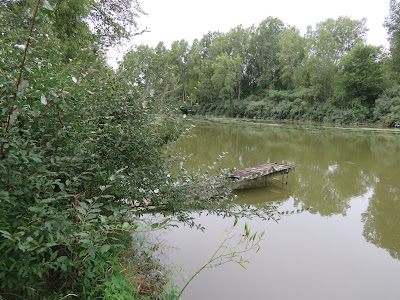Under overcast skies and temperatures in the mid 60’s, I’m about a mile upstream from my last encounter with Pine Creek, standing on the south end of impounded Rainbow Lake, watching water flow through the dam’s spillway to form the creek as it flows south toward Maple Rapids. In the early 1960’s, Pine Creek was dammed to form the 300-acre Rainbow Lake. During the great flood of 1986, the dam was breached and the lake was drained (stock photo). In 1989, the dam was rebuilt and the lake restored. Following a path on a high bank of the creek, I notice some blossoms of Queen Anne’s Lace remain open while others have folded up and seeded out. After opening one of these cup-like “nests”, I’m not surprised to see a live, colorful, ½ inch, Carrot Seed Moth Caterpillar. The invasive moth from this caterpillar (stock photo) was first noticed in North America in 2002. Some researchers suggest that the moth may have hitchhiked on a trans-Atlantic vessel that ended up at a Great Lakes port. So far, this insect has had minimal impact on the ecosystem. Up ahead, I spot the conspicuous white rump patch of a Northern Flicker as it flies away and perches in a nearby tree where it repeats its loud, single-note call. Scanning the sky, I watch an Osprey circle overhead and land at the top of a nearby cell-phone tower. Ospreys, also called fish hawks, are excellent anglers. Over several studies, these birds of prey caught fish on at least 1 in every 4 dives, with success rates sometimes as high as 70 percent. The average time they spent hunting before making a catch was about 12 minutes. Walking back toward the car, I observe a Great Blue Heron standing on a dock. Back in the car, I head north about halfway up the lake and stop at a small park to explore the shoreline where I spot pale green berries of Poison Ivy and red berries of Maple-leaf Viburnum. In a few weeks, the toxic Poison Ivy berries will turn white and the toxic leaves red. Also, in a few weeks, the Viburnum berries will ripen to a dark blue color. While many types of Viburnum berries are edible and tasty, those of the Maple-Leaf variety are edible but not tasty. Nearby, I come upon a few stems of Common Teasel, topped with spiny seed pods and Hickory leaves displaying a condition called leaf spot, caused by a fungal pathogen. Moving down to the water’s edge, a yellow blossom of Nodding beggarticks catches my eye. Looking across the lake, I observe a wooded section of shoreline that remains undeveloped while most of it is occupied by high-end housing.
Late in summer
Nature’s décor
Sun shares less
Asters share more
Nests are empty
Redwings gone
Vigilant, the doe
Bolder, the fawn
Marsh still alive
Dragonflies hover
Blue Herons wade
More to discover
D. DeGraaf

Love the bit of history, and especially your poem.
ReplyDelete